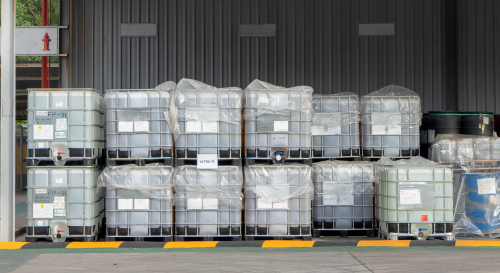
IBC totes are commonly used to store and transport large quantities of liquids, chemicals and other industrial products like solvents and lubricants. If you represent one of the many businesses that use these containers, you need to make sure you’re transporting them correctly. Otherwise, you could release these substances into the air, contaminating your facility and the local environment. A 275-gallon tote can weigh over 1,000 pounds, so precision and control are a must.
Learn more about some common mistakes when transporting these large containers and how to avoid them.
Puncturing the Tote with a Forklift
The last thing you want to do when moving your large IBC tote is accidentally puncture it with your forklift. Considering how large and heavy these containers tend to be, you’ll need a powerful piece of machinery to move the container properly. But unless both the container and the machine are positioned properly, you could skewer the container with the machine, causing a leak.
The container and the lift should be in a line, with the lift coming down on either side of the tote pallet. It’s best to find a tote with a four-way forklift entry, so you can pick it up from any direction.

Not Securing the Tote Properly
Moving an IBC tote with a forklift shouldn’t be a difficult task, but you need to make sure you have ahold of the container before trying to lift it off the ground. If your tote isn’t secured properly, it could fall off the forklift and become damaged, releasing chemicals or whatever else you’re storing inside.
When approaching the container with the forklift, make sure the arms of the lift go all the way through the holes in the pallet. Before you start whipping the container around, lift it off the ground a few feet to make sure the container isn’t slipping or falling. Move the forklift slowly as you transport the IBC tote and keep the pathway clean and flat. You don’t want to move your container through gravel, rocks or any uneven surface.
Using the Wrong Pallet to Secure the Tote
Pairing your IBC tote with the wrong type of pallet will only lead to trouble. These containers can weigh thousands of pounds, so if the pallet is too small or made with the wrong materials, the pallet could collapse under the weight of the tote, causing a leak and damaging the container.

To avoid this situation, it’s best to find a pallet that’s at least two feet thick. It can be made from plastic, steel or wood. Make sure the base of the IBC tote fits on top of the pallet. They should have the same dimensions, or the pallet should be wider than the tote. Ideally, the pallet will have a large metal cage around it that you can use to secure the pallet to the tote.
Removing the Lid Too Quickly
A lot can happen to an IBC tote during the transportation process. Chemicals and liquids can expand and contract or build up a lot of pressure that will be released when exposed to the air. That means that if you open the IBC lid too quickly, you or your team could get hit in the face with some of this built-up pressure.
Remember to open the lid slowly when unpacking the IBC tote. Just like handling a dropped can of soda, release the pressure slowly to make sure everyone stays safe.
Not Securing the Tote Before Moving
IBC totes are often used to transport dangerous chemicals and industrial materials that may be harmful to your health or the environment. If you fail to properly secure the tote before moving it, some of this liquid could leak out of the container and create a giant mess around your facility.
Make sure all lids, openings, fillings and vent holes are properly secured before attempting to move the container. Use the guidelines in the Title 49 Transportation document from the federal government as a reference to make sure you’re not putting your team or the environment at risk.
